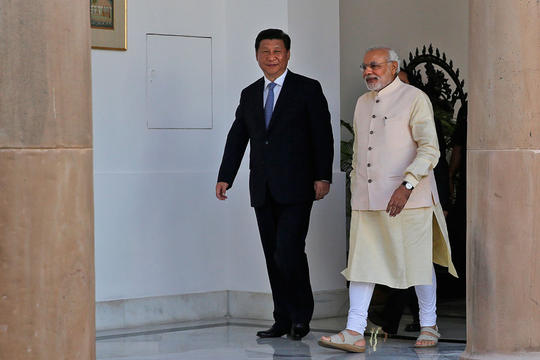Meanwhile, in China'.
Indian Prime Minister Narendra Modi and Chinese President Xi Jinping

NEW DELHI: United States President Barack Obama’s three-day visit to India culminated in bear hugs, fashion statements, a civilian nuclear deal, a defence agreement and a pledge to step up economic engagement. Meanwhile, China called Pakistan an “irreplaceable” friend as Chinese officials met visiting Pakistani Army chief General Raheel Sharif on Monday.
"Pakistan is China's irreplaceable all-weather friend and both countries (are) part of (a) community of shared destiny," Foreign Minister Wang Yi reportedly said, according to a spokesperson for the Pakistani army.
As China and Pakistan reaffirmed their mutual support, a close eye was kept on the US President’s visit to India. On Republic Day, Chinese President Xi Jinping, in a message addressed to President Pranab Mukherjee said he was keen to lift India and China's strategic cooperative partnership "to a higher level". In a separate message to Prime Minister Modi, Chinese Premier Li Keqiang said his government was "ready to work with India to deepen their mutually beneficial cooperation in various fields and build a closer partnership of development".
Whilst China issued statements reiterating its commitment to fostering bilateral ties, a joint statement signed by President Obama and PM Modi chiding Beijing for provoking conflict with neighbors over control of the South China Sea, drew a sharp response from Beijing. “We have made our position clear on this issue many times. China is staunch supporter promoter and contributor to regional peace and stability. We believe relevant disputes should be resolved by parties directly concerned through peaceful talks and consultation,” Hua Chunying, foreign ministry spokesperson said at the regular press briefing on Monday.
At the same briefing, the spokesperson was asked a question that’s been on everyone’s mind -- was the rekindled relationship between India and China an attempt to by the US to to use India to contain China? “I do not think that kind of cold war mentality will work in the 21st century. And, India too is unlikely to be part of any such alliance,” Hua said, adding that Indo-China relations have seen a major upswing in the last year. Indian Foreign Minister Sushma Swaraj is slated to be in Beijing later this week.
Nevertheless, the analysis differs. An article in The New York Times for instance describes the improved Indo-US ties as a major achievement for the latter. Authored by Baker and Harris the article states, “For years, American presidents have tried to enlist India, the world’s largest democracy, in a more robust partnership, partly to offset China’s rising power. India has had a long history of suspicion and rivalry with China, which allied with New Delhi’s archenemy Pakistan during the Cold War. But it has long insisted on being an independent actor in world affairs and resisted aligning itself with the United States against its giant neighbor. Mr. Modi, by contrast, seems not only willing but eager to redefine India’s relationship with the United States at a time China is on the rise economically, militarily and politically.”
The fact that China is more concerned about India and the US’ closer ties than it is letting on is evinced by a closer look at the media coverage accorded to President Obama’s India visit. An article in Xinhua authored by Tian Dongdong insists that India and China cannot be on the same page. “The shortened three-day visit is more symbolic than pragmatic, given the long-standing division between the two giants, which may be as huge as the distance between them,” Dongdong writes, adding “After all, only one year ago, U.S. diplomats were expelled from New Delhi amid widespread public outrage over the treatment of an Indian diplomat in New York and Narendra Modi, India's Prime Minister and then chief minister of Gujarat, was still banned from entering the United States.” “Three days are surely not enough for Obama and Modi to become true friends, given their hard differences on issues like climate change, agricultural disputes and nuclear energy cooperation,” Dongdong reasons.
The Global Times, a state-run Chinese paper took it a step further and accused the US of laying a trap for India. Wen Dao wrote, “Many reports by Western media have pointed out that the US, regardless of historical complications, is putting more efforts into soliciting India to act as a partner, even an ally, to support Washington's "pivot to Asia" strategy, which is mainly devised to counter China's rise. As for India, which has ambitions to be a major power, it needs US investment, technologies and political support so that its "Look East" foreign policy will better function to counterbalance China's growing influence.” However, “a trap is a trap. Although craftily set, it will be revealed eventually,” Dao warns.
A trap or not, PM Modi seems to be more determined to play an active role in Asian affairs, and India historically been wary of Chinese influence in the region -- especially amongst India’s immediate neighbours. President Obama, in turn, has been pushing his own so-called “pivot to Asia” strategy.
Although India and the US have not (despite having their own reasons to be wary of Chinese influence) yet aligned their positions in reference to China, some recent developments may have contributed to a move toward a consensus. These include the presence of Chinese submarines in the Bay of Bengal -- which India considers its strategic backyard. It also includes border tensions during President Xi Jinping’s visit, when Chinese troops confronted Indian troops in Ladakh. Most recently, it involves a proxy war over Sri Lanka, where analysts believe India covertly intervened to prop up Maithripala Sirisena, who won the elections earlier this month.
The Citizen had reported on India’s “coup” against former Sri Lankan President Rajapaksa, noting that the former leader’s closeness to China was perhaps a key reason behind India’s decision to intervene.
India and the US’ friendship, at least in reference to China, falls in line with the dictat, “the enemy of my enemy is my friend.”



